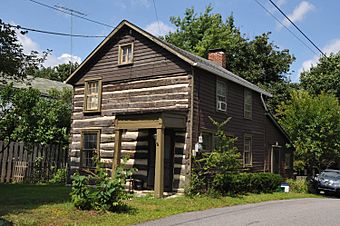Newville Historic District facts for kids
Quick facts for kids |
|
|
Newville Historic District
|
|

1795 log cabin
|
|
| Location | Roughly bounded by Cove Alley, Big Spring Creek, the Cumberland Valley Railroad right-of-way, Washington St., Newville, Pennsylvania |
|---|---|
| Area | 86.6 acres (35.0 ha) |
| Architectural style | Italianate, Gothic Revival, Greek Revival, Queen Anne, Second Empire, Colonial Revival, Federal, Georgian, Late Victorian |
| NRHP reference No. | 10000397 |
| Added to NRHP | June 28, 2010 |
The Newville Historic District is a special area in Newville, Pennsylvania, located in Cumberland County, Pennsylvania. It's like a protected neighborhood where many old and important buildings are kept safe. This district is officially recognized as a historic place because of its unique past and architecture.
The Newville Historic District covers an area roughly bordered by Cove Alley, Big Spring Creek, the Cumberland Valley Railroad tracks, and Washington Street. It includes 414 buildings, one special site, and two objects that all help tell the story of Newville's history. These historic spots are found in the town's main business area and the homes around it.
Exploring Newville's Historic Past
Most of the important buildings in this historic district are homes. They were built between 1790 and 1950. The very oldest house is a log cabin from 1795.
But it's not just houses! The district also includes:
- The Big Spring Presbyterian Church, built in 1790.
- Five other churches.
- Two government buildings.
- Nine commercial buildings (like shops).
- Three social buildings (places where people gathered).
- One school building.
- One industrial building (like a factory).
There are also two special objects:
- A fountain from 1899.
- A memorial monument from 1940, honoring the Veterans of Foreign Wars.
The Big Spring Presbyterian Cemetery, which dates back to about 1777, is also an important part of the district. All these places are called "contributing" because they add to the historical importance of the district.
Becoming a National Historic Place
To become a recognized historic district, a place needs to be reviewed by experts. The Newville community wanted their district to be added to the National Register of Historic Places. This is a list of places across the country that are important to American history.
The application for the Newville Historic District was looked at by the Historic Preservation Board of the Pennsylvania Historical and Museum Commission. This happened at a meeting on October 6, 2009. After careful review, the Newville Historic District was officially added to the National Register of Historic Places in 2010. This means it's now recognized as a significant part of our nation's history.



